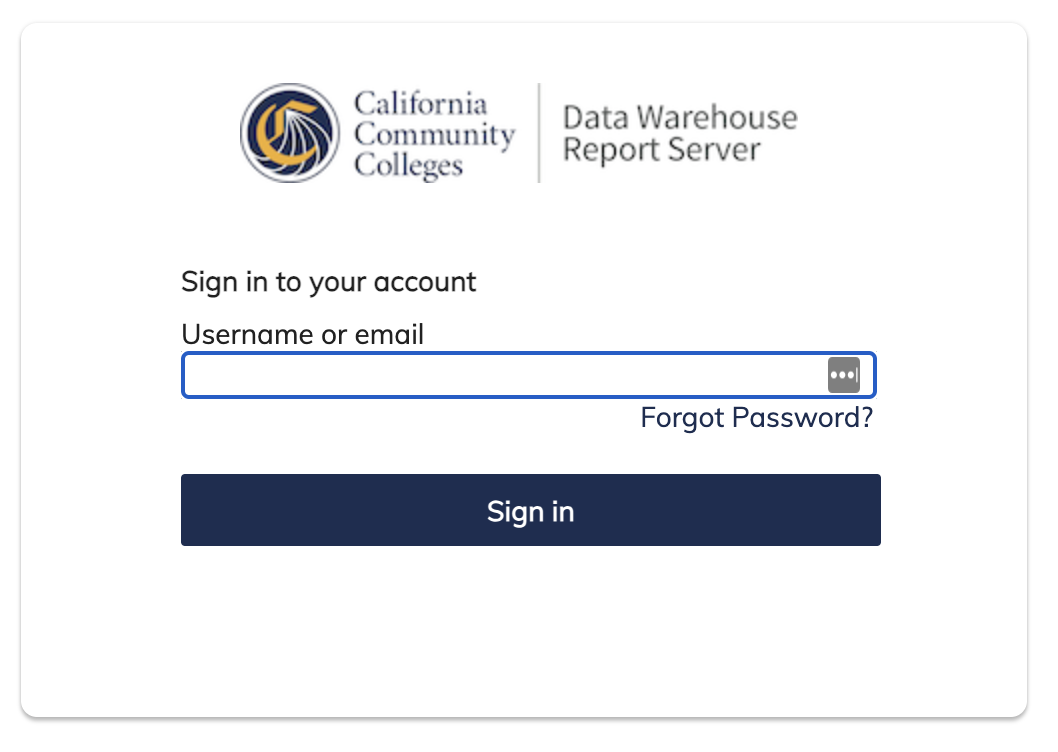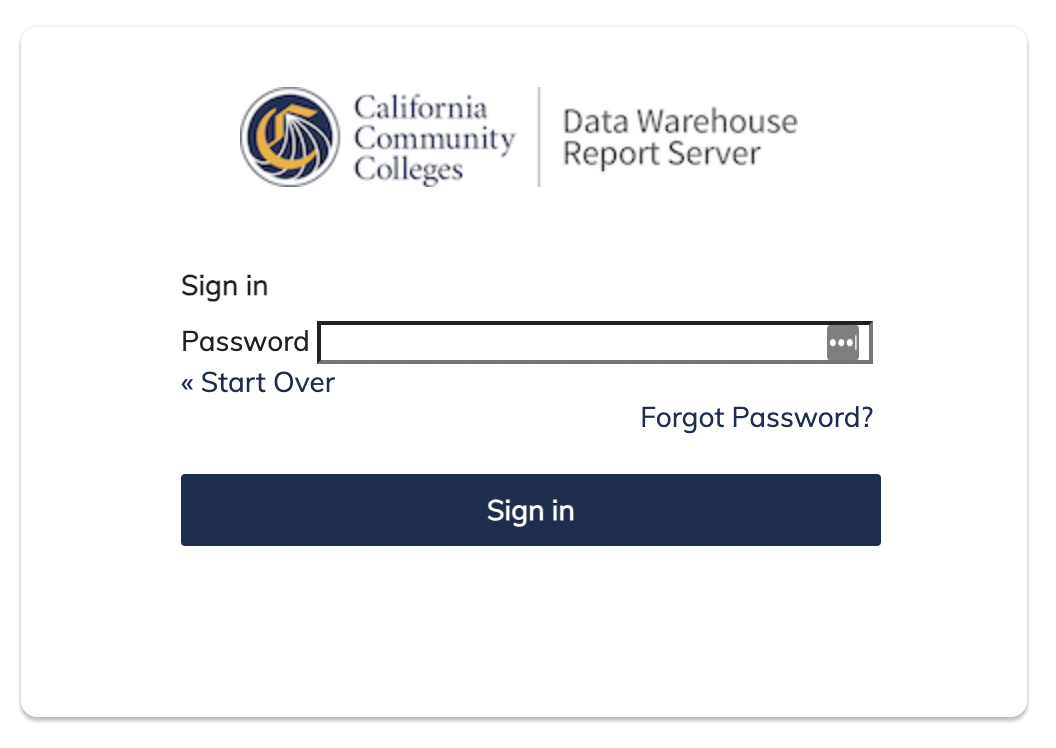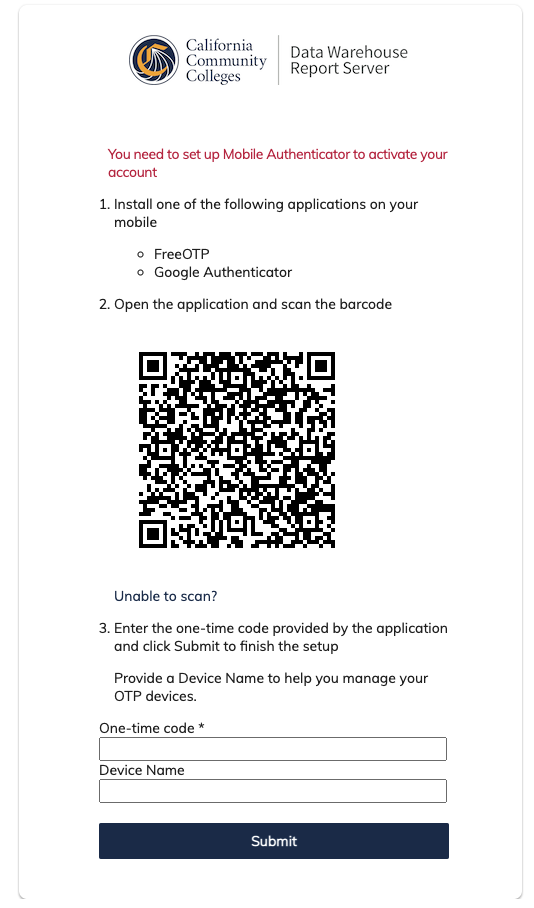| Panel |
|---|
| panelIconId | atlassian-info |
|---|
| panelIcon | :info: |
|---|
| bgColor | #F4F5F7 |
|---|
|
This guide is for the Data Warehouse Report Server (CCC Data 2.2.0) released to production on January 27, 2023. |
...
Before a user can log into the DWRS the following conditions must be met:
The You - the authorized user has - have followed the Getting Started tips above and has have coordinated with CCCTC Enabling Services to begin the account creation and configuration process based on their your user type and access level.
CCCTC Enabling Services has created your account and has sent your account credentials via secure method.
The Your account has been configured with the appropriate rolesrole(s), attributes, and - for SSO Users only - their institution’s IDP linkyour college or district’s IDP information (for college and district SSO Users ONLY).
SSO Users Only: You have received their your unique college or district URL, configured to their IDP, and know their DWRS URL bookmarked and you know your IdP single sign-on credentials provided to them by their your college or district’s district IT department.
Non-SSO Users Only: You have received their your account credentials and temporary password from a CCCTC Enabling Services Administrator, ; youhave installed the an authentication software app software, and have completed the “First-Time User Log In” process (setup and verification tasks) required to facilitate two-factor authentication at the generic DWRS URL.
SSO Users: Account Setup & Log In Process
...
The User coordinates with the CCCTC Enabling Services implementation team and receives acknowledgment that their account has been created with the appropriate roles and attributes, and the IDP has been linked.
The User is directed to the appropriate DWRS URL for their IDP and logs in.
The User is authenticated through their institution IDP (SSO) and is logged in to the DWRS.
...
The User coordinates with the CCCTC Enabling Servicesimplementation team and receives their account credentials and first-time user setup login information via secure method (i.e., Privnote).
The User downloads and installs a compatible authentication software on their desktop or mobile device.
The User completes the “First-time User Log In” process, which enables entry of account credentials, one-time QR code verification, and authentication to the DWRS.
Optional: After logging in, the User may update their temporary password using the Forgot Password? link to reset their password.
...
For security purposes, all non-SSO users will receive their your account credentials and temporary password in one or two separate emails from the an CCCTC Enabling Services Administrator. The email(s) will include a link to a secure Privnote message, sent to their the user’s institution email address (.edu).
| Panel |
|---|
| panelIconId | atlassian-warning |
|---|
| panelIcon | :warning: |
|---|
| bgColor | #F4F5F7 |
|---|
|
Note: The password will not be passed to the authorized user until they have started the implementation process with the CCCTC Enabling Services teamfor added security. |
Implementing the Authentication Software
...
| Expand |
|---|
| title | Expand here to see the First-Time User Log In steps (one-time process). |
|---|
|
| Note |
|---|
Non-SSO Users Only: Complete this one-time process using the steps below. |
Step 1: Enter Your Account Credentials on the Log In PagesEnsure you have one of the compatible authenticator apps installed on your desktop or mobile device.
Navigate to the Data Warehouse Report Server URL for non-SSO users (https://dw-reports.ccctechcenter.org/jasperserver-pro/login.html); land on the log in page.
Enter your Username or Email Address (institutional email address) in the Username or email input field (.edu or .org is required) on the main “Sign in to your account” screen. Click “Sign In” to proceed to the nextscreen.
Enter the your temporary Password provided to you by the CCCTCEnabling Services Administrator (sent separately via Privnote). Click the “Sign in” button to continue to the QR Code Scan screen.
|  
|
| Panel |
|---|
| panelIconId | atlassian-info |
|---|
| panelIcon | :info: |
|---|
| bgColor | #F4F5F7 |
|---|
| The temporary password is generated by the CCCTC Enabling Services Administrator during the account creation process. You can change this password at any time by using the “Forgot Password?” link. |
Step 2: Scan the QR Code PageThe Scan the QR Code page is displayed once during the “first-time user log in” process. The user must have the authentication software installed on their desktop or mobile device in order to scan the QR code that appears on the page. The code is captured by the authenticator app which establishes the connection between the account (shared secret key hidden in the barcode) and the authenticator app to complete the initial two-factor authentication process.
With your Authenticator App installed, scan the QR code that appears in the center of the page. Scanning the QR Code with Chrome Authenticator (from desktop). Scanning the QR Code with Google Authenticator(usinga mobile device).
As the authenticator scans the barcode (QR Code), a six-digit verification code will appear/register in your authenticator app.
As soon as you see the six-digit code appear in your authenticator app, copy the code and then click “Submit” to go to the next page.
| Panel |
|---|
| panelIconId | atlassian-warning |
|---|
| panelIcon | :warning: |
|---|
| bgColor | #F4F5F7 |
|---|
| NOTE: This step requires the user to use theirauthentication app previously installed on their desktop or mobile device to scan the onscreen barcode. The “secret” key identified by the barcode will add the required attribute to the User’s account. |
|  |
Using Chrome Authenticator to Scan the QR CodeOnce the Chrome Authenticator app has been installed, a shortcut will appear in your Extensions toolbar in your browser. Click the Authenticator icon in your Extensions toolbar to open the tool. Click the scan icon and move your mouse over the QR barcode in the center of the page. Click + hold the mouse to drag the scan functional across the bar code. The secret key hidden within the barcode will register as a six digit code in the Authenticator registered to your Report Server account.
|  | Using Google Authenticator to Scan the QR CodeOnce the Google Authenticator app has been installed on your mobile device, an icon will appear on your phone wall or homepage. Click to open the Google Authenticator app Point the camera on your mobile device at the barcode on the screen and snap a picture. The secret key hidden within the barcode will register as a six digit code in the GA app registered to your DW Report Server account.
| |
| Panel |
|---|
| panelIconId | atlassian-check_mark |
|---|
| panelIcon | :check_mark: |
|---|
| bgColor | #F4F5F7 |
|---|
| Tip: After scanning the QR code and confirming the verification code is captured by the authentication software, snap a screen shot of the code and store in a secure place. For security purposes, don’t store the verification code with the URL or other credentials to the DWRS. |
|
...
On the Home page, click Create in the Reports block. The Create Report wizard opens.
Select the Ad Hoc view you want to use as the basis for your report.
Select a report template. To use a template other than the default, select Custom Report Template, click Browse and select the desired template. See Report Templates for more information.
Click OK. If asked, enter the input controls needed. See Using Input Controls.
...
| Panel |
|---|
| panelIconId | atlassian-info |
|---|
| panelIcon | :info: |
|---|
| bgColor | #F4F5F7 |
|---|
|
Creating Filters with Relative Dates You can filter information in your view based on a date range relative to the current system date. You can accomplish this using date-based filters, and entering a text expression describing the relative date or date span you want to display, using the format <Keyword>+/-<Number> where: Keyword indicates the time span you want to use. Options include: DAY, WEEK, MONTH, QUARTER, SEMI, and YEAR. An option used by itself (without +/-<Number>) gives the current value for that option. + or - indicates whether the time span occurs before or after the chosen date. Number indicates the number of the above-mentioned time spans you want to include in the filter.
For example, if you want to see all of the CC Promise Grant Applications submitted during the prior week, your expression would be: WEEK-1. |
...



